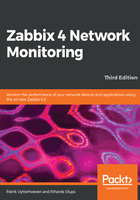
Zabbix features and architecture
Zabbix provides many ways of monitoring different aspects of your IT infrastructure and, indeed, almost anything you might want to hook up to it. It can be characterized as a semi-distributed monitoring system with centralized management. While many installations have a single central system, it is possible to use distributed monitoring with proxies, and most installations will use Zabbix agents.
What features does Zabbix provide? Let's have a look:
- A centralized, easy to use web interface
- A server that runs on most UNIX-like operating systems, including Linux, AIX, FreeBSD, OpenBSD, and Solaris
- Native agents for most UNIX-like operating systems and Microsoft Windows versions
- The ability to directly monitor SNMP (SNMPv1, SNMPv2c, and SNMPv3) and IPMI devices
- The ability to directly monitor Java applications using JMX
- The ability to directly monitor vCenter or vSphere instances using the VMware API
- Built-in graphing and other visualization capabilities
- Notifications that allow easy integration with other systems
- Flexible configuration, including templating
- Low-Level Discovery (LLD) and the ability to generate items, graphs, and triggers (among others) in an automated way
- A lot of other features that allow you to implement a sophisticated monitoring solution
If we look at a simplified network from the Zabbix perspective, placing the Zabbix server at the center, the communication of the various monitoring aspects matters. The following diagram depicts a relatively simple Zabbix setup with several of the monitoring capabilities used and different device categories connected:

The Zabbix Server directly monitors multiple devices, but a remote location is separated by a firewall, so it is easier to gather data through a Zabbix proxy. The Zabbix proxy and Zabbix agents, just like the server, are written in the C language.
Our central object is the Zabbix database, which supports several backends. The Zabbix server, written in the C language, and the Zabbix web frontend, written in PHP, can both reside on the same machine or on another server. When running each component on a separate machine, both the Zabbix server and the Zabbix web frontend need access to the Zabbix database, and the Zabbix web frontend needs access to the Zabbix server to display the server status and for some additional functionality.
While it is perfectly fine to run all three server components on a single machine, there might be good reasons to separate them, such as taking advantage of an existing high-performance database or web server.
In general, monitored devices have little control over what is monitored—most of the configuration is centralized. Such an approach seriously reduces the ability of a single misconfigured system to bring down the whole monitoring setup.
In the following diagram, we have an overview of the basic Zabbix setup with our Zabbix server, web server and relational database. In our setup, we will install the three components on one machine. It is possible, however, to split up components over three different machines, something we will see later in this book:
